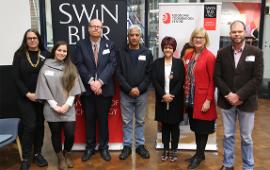First nations, first astronomers: understanding Indigenous astronomy

In Summary
- The Swinburne Annual Reconciliation Lecture explored Indigenous astronomy knowledge and practices
- The event was co-hosted by Swinburne, the Moondani Toombadool Centre and the Centre for Supercomputing and Astrophysics
Indigenous astronomy embodies a wealth of knowledge including using stars as a calendar, a navigation tool and a canvas through which to tell rich stories, the audience of Swinburne’s Annual Reconciliation Lecture has heard.
Titled ‘First Nations, First Astronomers’, the 2019 lecture was delivered as a panel discussion between Gunnai and Yorta Yorta custodian Uncle Wayne Thorpe, Kamilaroi woman and Monash University astrophysics student Krystal De Napoli, and cultural astronomer Dr Duane Hamacher.
The event was co-hosted by Swinburne’s Moondani Toombadool Centre and the Centre for Astrophysics and Supercomputing, and the discussion was moderated by Swinburne Dean of Science, Professor Virginia Kilborn.
Uncle Wayne Thorpe explained the connection to astronomy is of great significance to Gunnai people.
“We had to rely on our observation and our connection to country. Looking at the stars and the night sky, we’re really reading our calendar of events. We’re looking to see what sort of foods are in season, the indicators that tell us important ceremonies are about to happen and where we need to travel to for those ceremonies,” he said.
Born in Missouri in the United States of America, Dr Hamacher came to Australia to learn more about astrophysics and never expected to become so deeply embedded in, and passionate about, Australian Indigenous astronomy.
“I knew that I could learn about the culture, but I didn’t have those connections and roots to the culture. But being an astronomer and having a background in astrophysics, I was armed with the tools necessary to see the science behind the traditional knowledge,” he said.
Dr Hamacher explained it is a misconception that Indigenous astronomy isn’t founded in science and that it only serves as a tool for telling stories.
“There are multiple layers and levels to all this knowledge I’ve learned about. One of the foundational levels of that is science. There’s a lot there that isn’t being tapped into or understood.”
Interpreting the stars in diverse ways
As part of her astrophysics studies, Ms De Napoli has been investigating the similarities and differences between Indigenous interpretations of certain constellations and Western astronomy.
“As an astrophysics student, I’m able to explore the cross-section between my culture and my scientific studies. I’m currently working on a project looking at the Pleiades star cluster, also known as the Seven Sisters. The stories from different Aboriginal communities across Australia vary quite a lot in how they interpret this cluster.
“I’m exploring why the number of stars mentioned in these oral traditions varies and why they are often referred to as sisters or women. This is where I get to bring in my own cultural knowledge but also use my astrophysics knowledge to look at each star.”
Uncle Wayne Thorpe said he grew up learning about the Western interpretations of constellations, such as the “Saucepan”, as well as his Gunnai ancestors’ stories.
“Along the way, I’ve had Elders point out constellations and explain that at certain times of the year, that pot will scoop up the evening light, travel across the sky throughout the night and then tip out the morning light,” he said.
The importance of sharing Indigenous knowledge
Ms De Napoli said her experience of learning about Indigenous culture at school was very different to the way her family educated her about her heritage.
“At school, I was taught that Indigenous people were nomadic wanderers and that there was nothing really here before. I find this quite sad because I think it really impacts on how you start to see yourself as an Indigenous Australian,” she said.
“For me, my life’s passion is to help re-write that so Indigenous people can grow up learning about the rich history of their heritage and feel proud of it.
“There are incredible things to learn within Indigenous astronomy. There have been amazing discoveries in the last 200 years of modern day science that pop up in Aboriginal oral traditions, some of which date back tens of thousands of years.”
Dr Hamacher said he was honoured to be involved in writing the curriculum for updated Indigenous studies being introduced into primary and secondary schools.
“We wanted to showcase the depth of the knowledge and integrate the two knowledge systems. We shouldn’t be viewing traditional knowledge as some relic from the past. Western science changes all the time and we’re always learning new stuff. The same thing goes with what I’ve learned from Indigenous Elders.
“So, why not look at ways these two areas can work together? If you’re teaching astrophysics and looking at star formations, why not bring in the Aboriginal traditions that talk about similar concepts?”
Ms De Napoli was thrilled to hear the announcement that Indigenous astronomy is being incorporated into primary and secondary education.
“I’m really excited because this is something that Indigenous students can take on board and feel a sense of pride about their heritage. But also, it’s important for all Australians to realise how lucky we are to learn from some of the oldest continuing cultures and possibly the first astronomers.”

